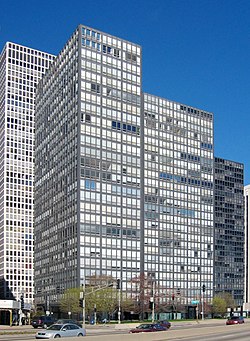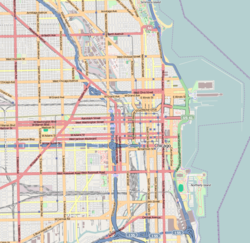860-880 Lake Shore Drive Apartments
|
Buildings at 860–880 Lake Shore Drive
|
|

860–880 Lake Shore Drive
|
|
| Location | 860–880 N. Lake Shore Drive Chicago, Illinois |
|---|---|
| Coordinates | 41°53′55″N 87°37′7″W / 41.89861°N 87.61861°WCoordinates: 41°53′55″N 87°37′7″W / 41.89861°N 87.61861°W |
| Area | 1.2 acres (0.49 ha) |
| Built | 1949 |
| Architect | Ludwig Mies Van der Rohe |
| Architectural style | International Style |
| NRHP Reference # | 80001344 |
| Significant dates | |
| Added to NRHP | August 28, 1980 |
| Designated CL | June 10, 1996 |
860–880 Lake Shore Drive is a twin pair of glass-and-steel apartment towers on N. Lake Shore Drive along Lake Michigan in the Streeterville neighborhood of Chicago, Illinois. Construction began in 1949 and the project was completed in 1951. The towers were added to the National Register of Historic Places on August 28, 1980, and were designated as Chicago Landmarks on June 10, 1996. The 26 floor, 254 ft (82 m) tall towers were designed by the architect Ludwig Mies van der Rohe, and dubbed the "Glass House" apartments. Construction was by the Chicago real estate developer Herbert Greenwald, and the Sumner S. Sollitt Company. The design principles, first expressed in the 1921 Friedrichstrasse Skyscraper competition in Berlin and built thirty years later in 860–880 Lake Shore Drive, were copied extensively and are now considered characteristic of the modern International Style as well as essential for the development of modern High-tech architecture.
The towers were not entirely admired at the time they were built, yet they went on to be the prototype for steel and glass skyscrapers worldwide. Initially, it was difficult to acquire financing for the project, turned down by lenders like Baird & Warner, who considered the design scheme to be too extreme. 860–880 Lake Shore Drive Apartments embody a Modernistic tone with their verticality, grids of steel and glass curtain walls (a hallmark of Mies’ skyscrapers), and complete lack of ornamentation. Tenants had to accept the neutral gray curtains that were uniform throughout the buildings;no other curtains or blinds were permitted lest they mar the external appearance. Since Mies was a master of minimalist composition, his principle was “less is more” as it is demonstrated in his self-proclaimed “skin and bones” architecture.
...
Wikipedia

